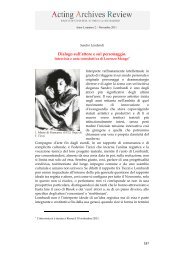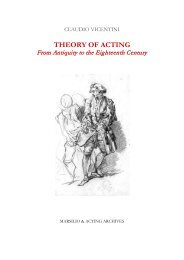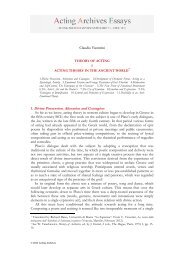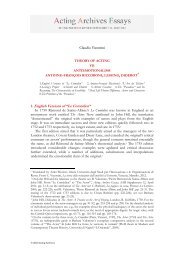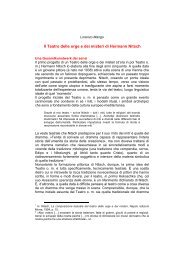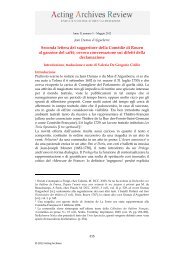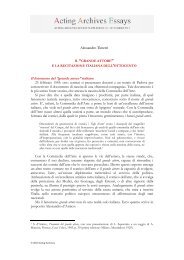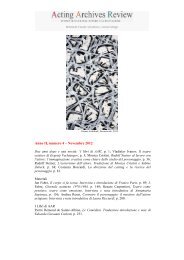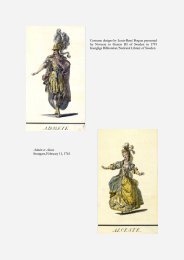Maria Ines Aliverti_The Miniatures of Jean Louis ... - Acting Archives
Maria Ines Aliverti_The Miniatures of Jean Louis ... - Acting Archives
Maria Ines Aliverti_The Miniatures of Jean Louis ... - Acting Archives
Create successful ePaper yourself
Turn your PDF publications into a flip-book with our unique Google optimized e-Paper software.
AAR <strong>Acting</strong> <strong>Archives</strong> Essays Supplement 10 – April 2011<br />
To modern eyes these costumes might seem extravagant or even ridiculous, but at<br />
the time they must have been extremely important, due precisely to the coherent<br />
attempt to render specific historical contexts. 67<br />
Although important, these observations do not fully exhaust the question <strong>of</strong> the<br />
documentary value <strong>of</strong> the vignettes. This depends, in fact, not only on the<br />
faithfulness <strong>of</strong> the costumes depicted to the originals, but also on aspects related to<br />
the interpretation <strong>of</strong> the actors, rendered explicit in the choice <strong>of</strong> a precise moment<br />
<strong>of</strong> the performance, in the lines, which are <strong>of</strong>ten indicated, in the movements and the<br />
gestures <strong>of</strong> the speakers, in their expressions, rendered with individual detail, and<br />
finally in the spatial and proxemic relations. Although essential – they are, after all,<br />
only actors in costume performing in an empty space – these images reflect a precise<br />
aim to record the jeu <strong>of</strong> the actor.<br />
How? And, first <strong>of</strong> all, how and why did they become established, these little<br />
representations <strong>of</strong> the stage? What examples inspired Faesch, and perhaps also<br />
Lekain, who might have been his first patron together with Preville and Monnet?<br />
What method was used, at least initially, to portray the actors?<br />
Almost all these images present silhouettes in pr<strong>of</strong>ile; one might happily say all <strong>of</strong><br />
them, in fact, for even in the rare cases in which the bodies are shown in slight threequarter<br />
pr<strong>of</strong>ile, the faces are always drawn in full pr<strong>of</strong>ile. <strong>The</strong>re are at least two<br />
reasons behind this choice, aesthetic and technical: that is the theatrical quality and<br />
the faithfulness <strong>of</strong> the “shot”, to use a photographic term that will prove to be highly<br />
appropriate for the case in question.<br />
<strong>The</strong> tradition <strong>of</strong> costume figures does not seem to provide relevant precedents in<br />
this respect: in fact these almost always presented their fictional costumed<br />
performers frontally. Representation in pr<strong>of</strong>ile is not equally important for costumes,<br />
unless it is deemed necessary to highlight various aspects: the volume or the<br />
additional elements <strong>of</strong> cloth, the relationship between the outfit and the body and the<br />
gesture <strong>of</strong> the actor at a precise moment, the distance between one actor and<br />
another, considering the size <strong>of</strong> their costumes. This was also the opinion <strong>of</strong> Claude<br />
Gillot, who drew two impressionistic sketches <strong>of</strong> Baron as he performed with<br />
another actor: in this case, too, which in my opinion shows a significant change in<br />
the way <strong>of</strong> observing the actor on stage, the artist seems to favour full pr<strong>of</strong>ile. 68<br />
Representation in pr<strong>of</strong>ile also undoubtedly highlighted the need for actors to be<br />
completely absorbed in the scene they were performing, both alone and in dialogue<br />
with a fellow actor, without all the “distractions” or pleasant “digressions” that<br />
theatrical anecdotes narrate and that the eighteenth-century treatises on the reform <strong>of</strong><br />
the theatre look on with scorn, at times vaguely tinged (as in the case <strong>of</strong> the Paradoxe)<br />
67 <strong>The</strong> reference here is to the attention Lekain paid to theatrical costume. ‘Non moins familiarisé avec<br />
le dessin qu’avec les lettres, Lekain traçait lui-même ses costumes, conformément aux renseignements<br />
qu’il devait à ses recherches. C’est lui qui a établi dans cet important accessoire une vérité qu’avant lui<br />
on ne connaissait pas, et qu’il ne modifiait que pour lui donner plus de dignité. C’est lui qui substitua à<br />
la friperie burlesque, dont les héros de l’antiquité s’affublaient sur notre théâtre, des habits appropriés<br />
aux temps et aux mœurs auxquels appartenait l’action représentée’. [A. V. Arnault], Les Souvenirs et les<br />
regrets (1861), pp. 20-21.<br />
68 <strong>The</strong> two drawings in red chalk (sanguine), attributed to Claude Gillot; represent scenes from<br />
Racine’s Athalie (British Museum, 1937, 3.22.1) and from Corneille’s Horace (London, Private<br />
Collection). See Denis Sutton, ‘On two drawings by Claude Gillot’, <strong>The</strong> Burlington Magazine, 96, no. 614<br />
(May, 1954); M. I. <strong>Aliverti</strong>, Il ritratto d’attore, pp. 103-105.<br />
28



